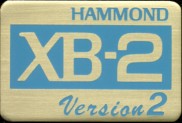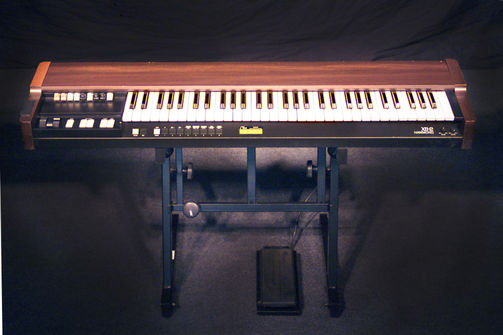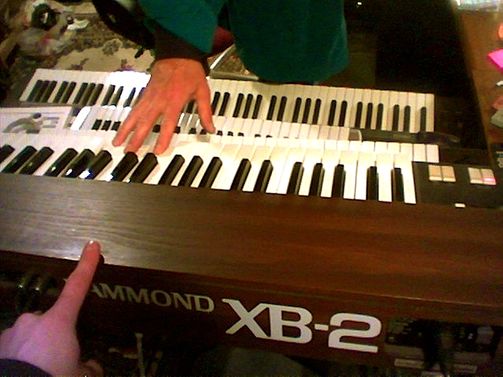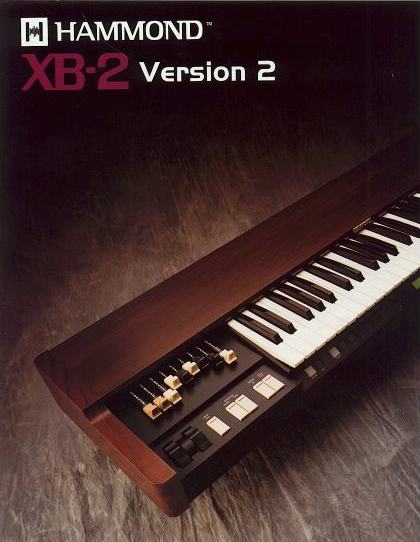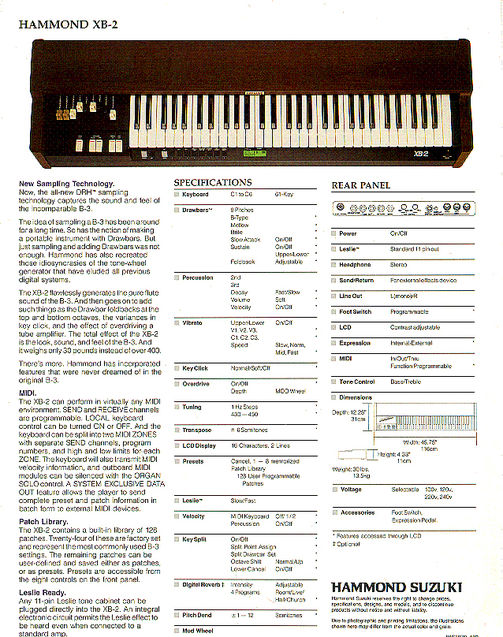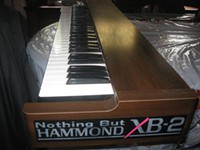- U bent hier: Home
- Hammond
- De Hammond Encyclopedie
- L-X series
- X series
- XB-2
HAMMOND XB-2
Na het mooie succes van de XB-1 ging Hammond dóór in ontwikkeling van de nieuwe, digitale techniek om aan de vraag uit de markt te voldoen, door steeds dichter bij het "good-old B-3" geluid te komen.
Hiervoor werd weer een stap verder in de techniek gedaan en ontstond de "DRH sampling technology" opdat het geheel zo ANALÓÓG mogelijk zou klinken.
De XB-2 klonk weer een stuk "vetter" dan z'n voorganger.
Hieronder het engelse verhaal waarmee Hammond de XB-2 aan de man bracht;
The Hammond B-3 is considered the "King" of all Hammond organs due to it's extensive use by professional and church organists worldwide throughout its production from 1955 to 1974. Today, over twenty years after the last Tonewheel Generator B-3
was produced at the Hammond Organ Factory in Chicago, Ill, the B-3 is still played by many touring and local performing professional and church organists.
Along with the tube-amplifier equipped Leslie Speaker Model 122, the 400 pound Hammond B-3 has rightfully earned a place in music history.
The size and weight problem has always been a factor for many musicians who desired
an alternative to moving and storing a B-3. Since the late 1960's, several Hammond portable organs and keyboards were developed as light-weight alternatives to the B-3,
such as the Porta-B (really an L-100 in a portable case) X-2, X-5 and B-200.
These Hammond models offered Hammond players several options to carrying the B-3
or other full size spinet and console organs.
Each successive model offered the latest in available technology and narrowed the tonal differences between the B-3 and themselves.
Recently Hammond developed the XB-2 keyboard which features a 61-Note keyboard equipped with Drawbars, Percussion, Reverb, Chorus/Vibrato and full MIDI implementation,
plus direct plug-in to 11-pin Leslie Models including the Classic 122XB and other
Leslie models with appropriate connector kits.
The Hammond XB-2 is the first choice of professionals worldwide who absolutely require the classic Hammond sound, but in a full feature keyboard.
Many touring professionals use custom XB-2 Touring Packages.
Working in conjunction with professional Hammond organists, keyboard players, church and home organists representing every style of music Hammond engineers designed the latest latest member of the long family of quality Hammond portables the XB-2.
Utilizing Hammond's own new state-of-the-art technology the classic sound and tonal qualities of the original B-3 were carefully incorporated into the new XB-2 and it's larger sister products, the XB-5 Pro-Portable organ, the XB-3 and the XC-3 which is identical to the XB-3 but housed in a church cabinet.
All previous attempts by other manufacturers at sampling a B-3 and adding Drawbars were simply not good enough to satisfy Hammond portable and keyboard owners
interested in a replacement for their aging Hammonds.
The new Hammond XB-2 includes all of the idiosyncrasies of the electro-mechanical Tonewheel Generator which formed the basis for the classic Hammond sound.
These tonal nuances were successfully captured in a digitally based keyboard, the Hammond XB-2.
The XB-2 digitally generates the pure harmonic sound of the classic B-3 including nuance characteristics of crosstalk, tonewheel bleed, etc. and other important features, such as the Drawbar foldbacks at the top and bottom octaves!
Key click and adjustable overdrive, user adjustable presets, percussion (adjustable), chorus and vibrato and other B-3 options were designed into the XB-2.
Some very early Hammond organ models lacked "foldback" found in the B-3 and similar models. These models had keyboards which were wired internally different with extra bass tones normally found only on the pedals of B-3 and other organ models with foldback.
Other later Hammond organ models had additional tones above the highest frequency tone found in a B-3.
The XB-2 can easily be configured to recreate these earlier or later organs to suit the organist's playing needs.
The XB-2 has earned solid acceptance from touring professional and church organists,
home and studio players worldwide by delivering the classic Hammond sound and performance.
The original B-3 weighed approximately 400 pounds. The new XB-2 weighs just 30 pounds and is the best choice for players requiring top keyboard performance at very reasonable cost.
In addition to the original features of the B-3 such as percussion, vibrato/chorus, etc.
the new XB-2 has incorporated many new features at the request of portable organ and keyboard owners.
Full MIDI Implementation:
The Hammond XB-2 can perform in virtually any MIDI environment. SEND and RECEIVE channels are programmable. LOCAL keyboard control can be turned ON or OFF and the keyboard can be split into two MIDI ZONES with separate SEND channels, program numbers and high and low limits for each ZONE.
The XB-2 will also transmit MIDI velocity information and outboard MIDI modules or devices can be silenced with the ORGAN SOLO control.
A SYSTEM EXCLUSIVE DATA OUT feature allows the user to send complete Preset and Patch information in batch form to external MIDI devices.
The XB-2 can be used as a master controller for the Hammond GM-1000 MIDI Sound Module or any other standard MIDI device, or can be used as a slave and controlled from the Hammond HA Series 88-Note weighted-key Digital Pianos or any other standard MIDI keyboard, module or controller.
On-Board Hammond Drawbar Patch Library
The Hammond XB-2 contains a built-in library of 128 Hammond drawbar patches.
Twenty-four are factory preset and represent the most commonly used B-3 drawbar settings in: Blues, Jazz, Gospel, Country, Rock and other music styles.
The remaining patches can be user-defined custom patches and saved either as patches or as one of eight presets controlled individually from the front panel.
Er kwam ook een flinke update naar VERSIE II
Upgrade your XB2 version One:
Bass and Treble, Overdrive, Overall Volume and Digital Reverb controls are adjustable through controls mounted on the front and rear of the XB-2.
These controls allow the user to tailor the sound from the early "mellow" Blues and Jazz,
or a later Hammond "bright" to the Hammond "growl" of Rock.
*Preset memory now enlarged to 32 presets.
De VERSIE II upgrade-sticker
En hieronder het XB-2 "prenten-kabinet"
Following the launch of the XB2 version 2, we have had many requests by version one users to make the new software available.
We now have the facilities to upgrade your old XB2 and give it a new lease of life. Following is a brief summary of the features of the new software.
Also Equipped with Leslie Simulator and 1/4" Stereo/Mono Line-Out
A specially designed internal Leslie simulator allows the user to utilize the XB-2's 1/4" Line Out jack and a standard amplifier/speakers mixing or PA equipment.
When an 11-pin Leslie is connected to the XB-2 the on-board simulator is automatically disconnected. If the 1/4" Line Out jack is used with a Combo Pedal Preamp and Leslie,
or another rotary horn device, it is very important, to turn the on-board Leslie simulator OFF through the control panel.
Although the simulator is excellent, if possible, for the best classic Hammond sound, a Leslie is required.
New Features
Five choices of vibrato speed slow, mid, normal, midfast & fast.
Independent Vibrato on/off for upper & lower manuals when in keyboard split mode.
Bender length independently selectable +/- 12 steps.
Percussion touch and velocity independently selectable.
16 volume levels for 2nd and 3rd touch response percussion.
Percussion key tracking, Volume of second and third percussion tapers off slightly at top end of keyboard, replicating the original Hammond.
Total of nine foot switch functions
Leslie slow/fast, UM Sustain, LM Sustain, Preset forward, MIDI start/stop,
UM damper, LM damper, Upper & Lower damper.
Key Click This menu ’Attack’ is now located on the drawbar menu five choices available Slow attack, No click, Soft, Normal, Max.
Drawbar foldback Foldback points can be selected by direct key input or scrolling.
Drawbar Volume and Filter Drawbar volume changes can be sent to a connected sequencer or module (e.g. Hammond XM1) via MIDI out.
Foot switch polarity Plus, Minus and alternate/ momentary mode.
Digital Leslie Now you can control the characteristics of your Leslie: Slow & Fast speeds, Rise Time, Fall time can all be adjusted.
MIDI velocity Increased to a total of six curves.
MIDI in split gate Incoming MIDI data can be set to not recognize keyboard split.
MIDI channel assignment You can now assign separate Midi channels for Upper & Lower Manuals, MIDI Zones 1 & 2 Also selectable on/off for each UM, LM and both zones.
MIDI keymapping High and Low limits for Upper & Lower Manuals (split) and MIDI zones 1 & 2. Key assignment can be done by direct key input and scrolling.
MIDI octave selection +/- 4 octaves for MIDI zones 1 & 2.
MIDI programme no. Variation no. You can select the midi variation number for each zone-ideal for use with the
MIDI Max & Min volume can be set for each zone.
Assignable controller numbers for Foot Switch, modulation wheel, Expression pedal and Leslie Fast touch tab.
MIDI Drawbar & switch sends the current Cancel Mode settings to a sequencer in preparation for playing back a sequence.
Data Dump Enhanced to five Memory dump options- All Out, Global, Cancel, Preset and Patch.
Hier eerste even géén vuurwerk, maar wel een mooiefilm-uitleg:https://www.youtube.com/watch?v=x0PUrfKOvis&feature=related
Maar hier gaan we even lekker los in de Jazz Kelder in Frankfurt met John Hammond en z'n band:
https://www.youtube.com/watch?v=JeJnFnvP3yw
